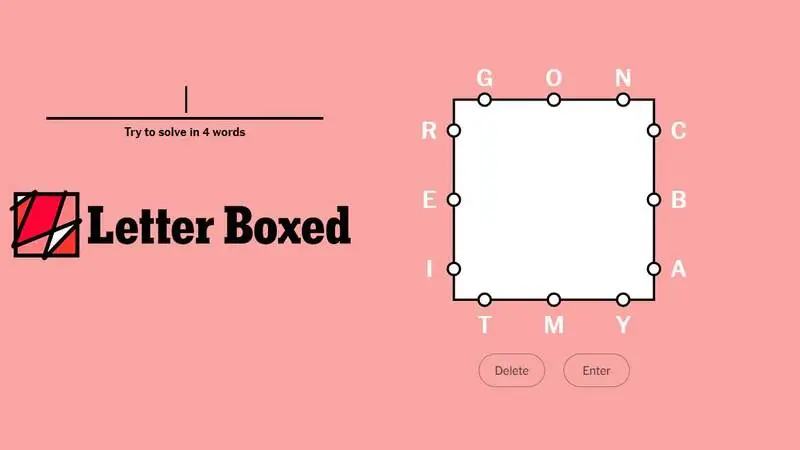Letter Boxed is a popular word puzzle game from The New York Times that challenges players to create words using letters arranged around a square. The objective is to connect all the letters in the square by forming words, with the added constraint that consecutive letters in a word must come from different sides of the square. In this comprehensive guide, we’ll explore the intricacies of Letter Boxed, provide strategies for solving puzzles, and offer examples and tips to help you become a Letter Boxed Answers master.
Understanding the Basics of Letter Boxed
Game Rules
- Letter Arrangement: The puzzle presents 12 letters arranged around a square, with three letters on each side.
- Word Formation: Words must be formed by connecting letters from square sides. Consecutive letters in a word cannot come from the same side.
- Objective: The goal is to use all the letters in the square by forming words. Ideally, you should use the fewest number of words possible.
Winning Conditions
- All Letters Used: You must use all 12 letters at least once in the words you form.
- Fewest Words: Aim to solve the puzzle with the minimum number of words. While using more words is acceptable, the challenge is to find the most efficient solution.
Strategies for Solving Letter Boxed Puzzles
1. Analyze the Letter Distribution
Before forming words, take a moment to analyze the distribution of letters around the square. Identify common prefixes, suffixes, and root words that can be created using the available letters.
2. Identify High-Frequency Letters
Certain letters, such as vowels (A, E, I, O, U) and common consonants (R, S, T, L, N), are more likely to appear in multiple words. Identify these high-frequency letters and consider how they can be incorporated into your solutions.
3. Look for Common Letter Pairings
Common letter pairings, such as “TH,” “CH,” “SH,” “ST,” and “QU,” can provide clues for forming words. Identifying these pairings can help you find starting points for your words.
4. Form Longer Words First
Longer words use more letters and can help you cover more ground quickly. Start by forming the longest words you can find using the available letters, then fill in the remaining letters with shorter words.
5. Consider Word Endings and Beginnings
Words that end with a particular letter can often lead directly to words that begin with that letter. For example, if you have a word ending in “E,” look for words that begin with “E” to continue the chain.
6. Use All Sides of the Square
Ensure that you’re using letters from all four sides of the square. This will help you avoid getting stuck with unused letters on one side.
7. Trial and Error
Don’t be afraid to experiment with different word combinations. If you find yourself stuck, try forming new words and see how they fit into the puzzle.
Examples of Letter Boxed Solutions
Let’s walk through a few examples to illustrate these strategies in action.
Example 1
Letter Arrangement: A, B, C / D, E, F / G, H, I / J, K, L
- Analyze the Letters: Notice the presence of common vowels (A, E, I) and consonants (B, C, D, F, G, H, J, K, L).
- Identify High-Frequency Letters: E, A, and I are common vowels that can be used in multiple words.
- Form Longer Words: Start with a longer word like “BACKFIELD” (B from side 1, A from side 2, C from side 1, K from side 3, F from side 2, I from side 3, E from side 2, L from side 3, D from side 2).
- Fill in Remaining Letters: Look for shorter words to use the remaining letters, such as “JIG” (J from side 4, I from side 3, G from side 1).
Solution: BACKFIELD, JIG
Example 2
Letter Arrangement: P, Q, R / S, T, U / V, W, X / Y, Z, A
- Analyze the Letters: Note the presence of less common letters (Q, X, Z) along with common ones (P, R, S, T, U, V, W, Y, A).
- Identify High-Frequency Letters: T, A, and S are common and versatile letters.
- Form Longer Words: Start with “PARTWAY” (P from side 1, A from side 4, R from side 1, T from side 2, W from side 3, A from side 4, Y from side 4).
- Fill in Remaining Letters: Use the remaining letters to form “QUIZ” (Q from side 1, U from side 2, I from side 4, Z from side 4).
Solution: PARTWAY, QUIZ
Example 3
Letter Arrangement: C, D, E / F, G, H / I, J, K / L, M, N
- Analyze the Letters: Identify common and high-frequency letters (C, E, G, I, L, N).
- Identify High-Frequency Letters: E, I, and N can be used in multiple words.
- Form Longer Words: Start with “CHILDREN” (C from side 1, H from side 2, I from side 3, L from side 4, D from side 1, R from side 1, E from side 1, N from side 4).
- Fill in Remaining Letters: Use remaining letters to form “FAMILY” (F from side 2, A from side 3, M from side 4, I from side 3, L from side 4, Y from side 4).
Solution: CHILDREN, FAMILY
Advanced Strategies for Letter Boxed
1. Use of Anagrams
Anagrams can help you identify potential word combinations that you might not have considered initially. Rearrange the letters to see if new words emerge.
2. Thematic Grouping
Sometimes, letters might suggest a specific theme or category (e.g., animals, colors, professions). Grouping letters by theme can help you quickly identify related words.
3. Cross-Referencing Dictionaries
Using online dictionaries or word lists can help you find obscure words that fit the letter arrangement. This can be particularly useful for solving more challenging puzzles.
4. Collaboration
Collaborating with friends or family can bring new perspectives and ideas. Different people may see different word combinations, making it easier to solve the puzzle together.
5. Practice and Patience
Like any skill, becoming proficient at Letter Boxed requires practice and patience. The more puzzles you solve, the better you’ll become at identifying patterns and forming words.
Common Challenges and How to Overcome Them
1. Limited Vowels
Challenge: A puzzle with few vowels can be difficult to solve, as vowels are essential for forming most English words.
Solution: Focus on creating words that use the available vowels efficiently. Consider using longer words that incorporate multiple vowels, and look for words that use less common consonant-vowel combinations.
2. Rare Letters
Challenge: Letters like Q, X, and Z can be challenging to use, especially if there are limited opportunities to pair them with other letters.
Solution: Identify words that specifically use these rare letters and plan your word formations around them. For example, “QUIZ,” “XEROX,” and “ZEBRA” are words that incorporate these rare letters.
3. Uneven Distribution
Challenge: Sometimes, the letters may be unevenly distributed, making it difficult to use all sides of the square effectively.
Solution: Ensure that you are considering all sides of the square when forming words. Use shorter words to bridge gaps between sides and balance the letter usage.
The Evolution of Letter Boxed
Origins and Popularity
Letter Boxed was introduced by The New York Times as part of their suite of word games. Its unique combination of word formation and spatial arrangement quickly made it a favorite among puzzle enthusiasts.
Impact on Word Games
Letter Boxed has influenced other word games by introducing the concept of spatial constraints in word formation. This innovation has inspired similar games and puzzles that challenge players to think creatively about letter placement.
Community and Competitions
The popularity of Letter Boxed Answers has led to the creation of online communities and competitions. Enthusiasts share their solutions, discuss strategies, and compete to find the most efficient solutions. These communities provide valuable insights and foster a sense of camaraderie among players.
Conclusion
Mastering Letter Boxed Answers requires a combination of strategic thinking, vocabulary knowledge, and creativity. By analyzing letter distributions, identifying high-frequency letters, and employing advanced strategies, you can become proficient at solving even the most challenging puzzles. Remember to practice regularly, collaborate with others, and stay patient as you refine your skills.
Whether you’re a casual player or a dedicated enthusiast, the tips and strategies outlined in this guide will help you navigate the complexities of Letter Boxed Answers and enhance your enjoyment of this engaging word puzzle game. So grab a pencil, open your Letter Boxed Answers puzzle, and start connecting those letters—your next solution is just a few strategic moves away! If you have any questions, please visit the Kaz World Mag.

